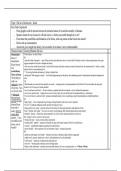Topic: Ode on a Grecian urn – Keats
Key Points/Arguments
- Poem grapples with the tension between the immortal nature of art and the mortality of humans
- Speaker resents the urn, because it will last forever, is history accessible through art or not?
- Poem about the possibilities and limitations of art forms, what can poems do that Greek urns cannot?
- Desire ends at consummation
- Ancient art gives insight into history, but on another level makes it never understandable
Themes/Context Literary/Dramatic Devices
Hermeneutics – 10 line stanzas – novelty of Keats
theory of S1
interpretation ‘unravish’d bride of quietness’ – virgin. Whenever Keats described beauty there is a lexical field of hostility (ravish is violent and passionate word), quiet
suggests metaphor of state (she is metaphor of silence)
(Keats interp of
‘slow time/ more sweetly than our rhyme’ -lexical field of serenity and silence, rhymes are marks of metrical time, also metatextual self – reflexive, calling
Urn) attention to the art your producing in art
Loss/deficency ‘?’ x5 growing frustration and urgency of trying to interpret form
Theory of forms ‘mad pursuit? What struggle to escape?’ – lexical field suggesting rape on the picture, also maddening pursuit of reading history through an inadequate art
everything on form
earth is an S2
inadequate creation ‘Heard melodies are sweet, but those unheard/ are sweeter’ – evoking pastoral, visual representation of lyrical form. This is what makes the song ideal,
of true form . Plato because it can’t be sung so it remains unsettled
and Aristotle tried ‘nor ever can those trees be bare’ - the urn is timeless, a perpetual spirit that is contained – tries to celebrate this permanence
‘never, never canst thou kiss’ – trapped, lovers can never leave, legacy lives on and they may be misrepresented (rep = permanence)
to distinguish
‘For ever wilt thou love, and she be fair!’–permanent immutable nature of never committing act (purity/frustration)thus no infidelity/heartbreak
between beauty S3
and truth (thought ‘happy, happy’ – tries to compensate for grim image of being bound by static form, excessive repetition
distracted them ‘For ever’ x3 anaphora emphasises chastity and hope of being given away
from truth of ‘panting, and for ever young’ – physical exertion of wild ecstasy of chore and pursuit (also crude depiction of lust)
reality), KEATS ‘heart’, ‘forehead’ and ‘tongue’ – now moves to carnal, visceral language. Body imitating human passion and mortality
marries them ‘breathing’, ‘burning’ – liberal desire, present participle ‘ing’ shows current, permanent pain they are stuck in
together… if you S4 – engaged in intense, dialectical hermeneutics
are truthful, moral ‘lowing at the skies’ – moans at doom (cattle), deep distress
‘mountain build’, ‘emptied’ – unnatural yet beautiful art, plays into broader semantic field of loss and deficiency
person, you are ‘evermore’ – enjambement emphasises perpetual loss and deficiency
beautiful ‘thou art desolate’ – throws questions of art as state/nature of piece – ontological questions
S5
‘marble men and maidens overwrought’ – alliteration robs them of humanity, highly artificial exaggerated
‘trodden weed’- parasitic, double stem = plosive, initial admiration of vase has diminished
‘Cold Pastoral!’ – dichotomy of admiration but artificiality of it
‘waste/woe’ – blends together weariness and fret of being human
‘Beauty is truth, truth beauty’- axiomatic (universal truth) chiasmic, like voice is echoing truth to us - Theory of Forms




